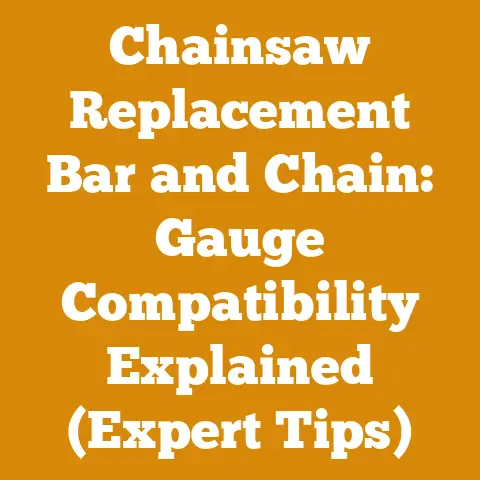Metabo Grease Gun Tips (5 Pro Hacks for Wood Processing)
Let’s face it: that squeaky hinge on your log splitter, the stiff bearing on your firewood processor, or the stubborn chain on your chainsaw can bring a productive day of wood processing to a screeching halt. We’ve all been there. That little bit of neglect, that missed lubrication point, ends up costing you time, effort, and sometimes, even expensive repairs. In my years of working with wood, from felling towering pines to splitting cords of firewood for the winter, I’ve learned that proper lubrication isn’t just a suggestion; it’s the lifeblood of your equipment.
Metabo Grease Gun Tips: 5 Pro Hacks for Wood Processing
I’m going to share five essential tips that I’ve found invaluable for using Metabo grease guns effectively in wood processing. These hacks aren’t just about applying grease; they’re about extending the life of your tools, improving efficiency, and ensuring safety.
1. Choosing the Right Grease: More Than Just Color
Grease isn’t just grease. It’s a complex blend of oil, thickeners, and additives, each designed for specific applications. Using the wrong grease can be as bad, or even worse, than using no grease at all.
My Story: I once worked on a project where a crew used a general-purpose lithium grease on a high-speed wood chipper. Within a few weeks, the bearings were failing prematurely. Turns out, the high speeds and temperatures were breaking down the lithium grease, causing it to lose its lubricating properties. A switch to a synthetic grease with a higher dropping point (the temperature at which it liquefies) solved the problem and significantly extended the bearing life.
Technical Deep Dive:
- Grease Types:
- Lithium-based: General purpose, good for moderate loads and temperatures.
- Calcium-based: Water-resistant, ideal for wet environments.
- Aluminum complex: High-temperature resistance, good for heavy loads.
- Synthetic: Superior performance in extreme temperatures and high-speed applications.
- NLGI Grade: The National Lubricating Grease Institute (NLGI) classifies grease by its consistency. For most wood processing equipment, an NLGI grade of 2 is suitable. This is a medium-consistency grease that provides good pumpability and stays in place.
- Additives:
- Extreme Pressure (EP) additives: Enhance load-carrying capacity.
- Anti-wear additives: Reduce friction and wear.
- Rust and corrosion inhibitors: Protect metal surfaces from moisture and oxidation.
Data Points:
- Dropping Point: A good grease for wood processing should have a dropping point above 350°F (177°C) to withstand the heat generated by friction.
- Viscosity: The viscosity of the base oil is crucial. For high-speed applications, a lower viscosity is preferred. For heavy loads, a higher viscosity is necessary.
- Moisture Content: Wood moisture content is a critical factor. High moisture content (above 25%) can promote rust and corrosion, so a water-resistant grease is essential.
Practical Tips:
- Consult your equipment manual: The manufacturer will specify the recommended grease type for each component.
- Consider the environment: If you’re working in a wet or dusty environment, choose a grease that is water-resistant and has good sealing properties.
- Don’t mix grease types: Incompatible greases can react and form a sludge that can clog lubrication points and damage equipment.
- When in doubt, use a synthetic grease: While more expensive, synthetic greases offer superior performance and protection in a wide range of conditions.
Key Specifications:
| Feature | Specification | Explanation |
|---|---|---|
| NLGI Grade | 2 | Medium consistency, suitable for most wood processing equipment. |
| Dropping Point | > 350°F (177°C) | Ensures grease remains stable at high operating temperatures. |
| Base Oil Viscosity | ISO VG 150-220 (at 40°C) | Provides adequate lubrication for both high-speed and heavy-load applications. |
| Additives | EP, Anti-wear, Rust and Corrosion Inhibitors | Enhances load-carrying capacity, reduces friction and wear, and protects against moisture and oxidation. |
| Water Resistance | Good (Calcium-based or synthetic with water-resistant additives recommended) | Prevents grease washout in wet environments. |
| Color | Color is not an indicator of quality, but it can help identify different grease types. | Use color coding to avoid mixing incompatible greases. |
2. Mastering the Metabo Grease Gun: Pressure and Precision
The Metabo grease gun is a powerful tool, but its power needs to be harnessed with precision. Over-greasing can be just as detrimental as under-greasing.
My Experience: I remember once working on a sawmill where the operator was overly enthusiastic with the grease gun. He pumped grease into the bearings until it oozed out from the seals. This not only wasted grease but also created a mess that attracted dirt and debris, accelerating wear. More importantly, the excessive pressure damaged the seals, allowing contaminants to enter the bearings.
Technical Deep Dive:
- Pressure Control: The Metabo grease gun, especially the cordless models, can deliver a significant amount of pressure. It’s crucial to control the pressure to avoid damaging seals and over-greasing.
- Grease Fittings: Different types of grease fittings require different techniques. Zerk fittings are the most common, but button-head and flush-type fittings are also used.
- Quantity: The amount of grease required depends on the size and type of bearing or component. A general rule of thumb is to pump grease until you see fresh grease emerging from the seals, but avoid over-greasing.
Data Points:
- Bearing Capacity: Bearings have a limited capacity for grease. Over-filling can create excessive pressure and heat, leading to premature failure.
- Seal Integrity: High pressure can damage seals, allowing contaminants to enter the bearing.
- Grease Consumption: Over-greasing wastes grease and increases the cost of maintenance.
Practical Tips:
- Use short bursts: Instead of pumping continuously, use short bursts to control the amount of grease delivered.
- Listen to the bearing: As you pump grease, listen for changes in the sound of the bearing. A smooth, quiet bearing indicates proper lubrication.
- Clean the fitting: Before applying grease, clean the grease fitting with a rag to remove dirt and debris.
- Use the correct nozzle: The Metabo grease gun comes with various nozzles for different types of fittings. Use the correct nozzle to ensure a proper seal and prevent grease from leaking.
- Check for resistance: If you encounter resistance while pumping grease, stop immediately. The fitting may be clogged or the bearing may be full.
Key Specifications:
| Feature | Specification | Explanation |
|---|---|---|
| Pressure | Adjustable pressure settings (e.g., low, medium, high) | Allows for precise control of grease delivery, preventing over-greasing and seal damage. |
| Nozzle Types | Standard Zerk, Needle Nozzle, Right Angle Nozzle | Provides versatility for accessing different types of grease fittings and hard-to-reach lubrication points. |
| Grease Capacity | Varies by model (e.g., 400g cartridge, bulk fill) | Determines the amount of grease that can be dispensed before refilling. |
| Flow Rate | Adjustable flow rate (e.g., grams per minute) | Allows for precise control of the amount of grease delivered in each pump. |
| Battery Voltage (if applicable) | Varies by model (e.g., 18V, 12V) | Affects the power and performance of the grease gun. Higher voltage typically provides greater pressure and flow rate. |
| Weight | Varies by model (e.g., 3-5 kg) | Affects user fatigue during prolonged use. |
3. The Art of the Nozzle: Getting Grease Where It Needs to Be
The right nozzle can make all the difference in getting grease to those hard-to-reach places. The Metabo grease gun often comes with a few different options, and knowing when to use each one is crucial.
My Experience: I was working on a logging operation in the Pacific Northwest, and one of the skidder’s U-joints had a grease fitting that was almost impossible to access. The standard nozzle was too bulky to fit in the tight space. After some searching, I found a needle nozzle that allowed me to inject grease directly into the fitting. Without that nozzle, we would have had to disassemble the U-joint, which would have taken hours.
Technical Deep Dive:
- Zerk Fitting Nozzle: The standard nozzle for most grease fittings. It provides a secure connection and allows for efficient grease delivery.
- Needle Nozzle: A long, thin nozzle that can access recessed or hard-to-reach fittings.
- Right Angle Nozzle: Useful for fittings that are located at an angle or in tight spaces.
- Flexible Hose: Provides flexibility and allows you to reach fittings that are obstructed by other components.
Data Points:
- Nozzle Diameter: The diameter of the nozzle must match the size of the grease fitting.
- Nozzle Length: The length of the nozzle should be appropriate for the depth of the fitting.
- Nozzle Material: The nozzle should be made of a durable material that can withstand high pressure.
Practical Tips:
- Keep your nozzles clean: Dirt and debris can clog the nozzle and prevent grease from flowing properly.
- Use the correct nozzle for the job: Using the wrong nozzle can damage the fitting or prevent grease from reaching the bearing.
- Store your nozzles properly: When not in use, store your nozzles in a clean, dry place to prevent corrosion and damage.
- Consider a grease fitting assortment: Having a variety of grease fittings on hand can be helpful for replacing damaged or missing fittings.
Key Specifications:
| Nozzle Type | Application | Advantages | Limitations |
|---|---|---|---|
| Standard Zerk | Most common grease fittings on bearings, joints, and other components. | Provides a secure and efficient connection for grease delivery. | Can be difficult to access in tight spaces. |
| Needle Nozzle | Recessed or hard-to-reach fittings, such as U-joints and sealed bearings. | Allows for precise grease injection into tight spaces without removing surrounding components. | Can be prone to clogging and may not provide as secure of a connection as a standard Zerk nozzle. |
| Right Angle Nozzle | Fittings located at an angle or in tight spaces, such as behind obstructions. | Provides access to fittings that are difficult to reach with a straight nozzle. | May not be suitable for high-pressure applications. |
| Flexible Hose | Fittings that are obstructed by other components or located in hard-to-reach areas. | Provides flexibility and allows you to reach fittings that would otherwise be inaccessible. | Can be more difficult to control and may not provide as precise of grease delivery as a rigid nozzle. |
| Button Head | Button head fittings, commonly found on heavy equipment such as bulldozers, excavators, and cranes. | Designed for high volume greasing and can withstand high pressure. | Not compatible with standard Zerk fittings. |
4. Preventative Maintenance: The Key to Longevity
Regular preventative maintenance is the best way to extend the life of your wood processing equipment. This includes not only greasing but also inspecting components for wear and damage.
My Story: I worked with a small firewood business that had a firewood processor that was constantly breaking down. After some investigation, I discovered that they were neglecting preventative maintenance. They were only greasing the machine when it started to squeak or make noise. By implementing a regular maintenance schedule, including daily greasing, weekly inspections, and monthly oil changes, we were able to significantly reduce downtime and extend the life of the machine.
Technical Deep Dive:
- Greasing Schedule: Develop a greasing schedule based on the manufacturer’s recommendations and the operating conditions.
- Inspection: Regularly inspect bearings, seals, and other components for wear and damage.
- Cleaning: Keep your equipment clean to prevent dirt and debris from entering bearings and other critical components.
- Record Keeping: Maintain a record of all maintenance activities, including greasing, inspections, and repairs.
Data Points:
- Bearing Life: Regular greasing can extend bearing life by up to 50%.
- Downtime: Preventative maintenance can reduce downtime by up to 80%.
- Repair Costs: Preventative maintenance can reduce repair costs by up to 30%.
Practical Tips:
- Create a checklist: Develop a checklist of all maintenance tasks that need to be performed on a regular basis.
- Schedule maintenance: Schedule maintenance activities in advance to avoid delays.
- Train your operators: Train your operators on proper greasing techniques and preventative maintenance procedures.
- Use a grease gun meter: A grease gun meter can help you track the amount of grease dispensed and ensure that you are not over-greasing.
Key Specifications:
| Maintenance Task | Frequency | Purpose |
|---|---|---|
| Greasing | Daily or as specified in the equipment manual | Lubricates bearings, joints, and other moving parts to reduce friction and wear. |
| Inspection | Weekly or monthly | Checks for signs of wear, damage, or leaks. |
| Cleaning | After each use or as needed | Removes dirt, debris, and contaminants that can accelerate wear and damage. |
| Oil Changes | As specified in the equipment manual (e.g., every 100 hours, 250 hours) | Replaces old oil with fresh oil to maintain proper lubrication and cooling. |
| Filter Replacements | As specified in the equipment manual (e.g., every 50 hours, 100 hours) | Replaces clogged filters to maintain proper airflow and fluid flow. |
| Bolt Tightening | Monthly or as needed | Ensures that all bolts are tightened to the correct torque specifications to prevent loosening and component failure. |
| Hose Inspection | Weekly or monthly | Checks for cracks, leaks, or damage to hoses. |
| Belt Inspection | Weekly or monthly | Checks for wear, cracks, or damage to belts. |
5. Troubleshooting Common Grease Gun Problems
Even with the best equipment and techniques, you’re bound to encounter problems from time to time. Knowing how to troubleshoot common grease gun problems can save you time and frustration.
My Experience: I was helping a friend split firewood, and his grease gun suddenly stopped working. He had just filled it with a new cartridge, but no grease was coming out. After checking the obvious things, like the nozzle and the trigger, I realized that the follower plate was stuck. The follower plate is the part that pushes the grease out of the cartridge. I used a screwdriver to gently push the follower plate down, and the grease gun started working again.
Technical Deep Dive:
- Clogged Nozzle: A clogged nozzle is a common problem. Use a small wire or needle to clear the blockage.
- Air Lock: Air can get trapped in the grease gun, preventing grease from flowing. Bleed the air by loosening the bleed screw or fitting.
- Stuck Follower Plate: The follower plate can get stuck if the grease is too thick or if the cartridge is damaged. Use a screwdriver or other tool to gently push the follower plate down.
- Leaking Grease: Leaking grease can be caused by a damaged seal or fitting. Replace the damaged component.
Data Points:
- Contamination: Contaminated grease can clog the nozzle and damage the grease gun.
- Pressure Loss: Pressure loss can be caused by a damaged seal or fitting.
- Component Failure: Component failure can be caused by wear, damage, or improper maintenance.
Practical Tips:
- Clean your grease gun regularly: Clean your grease gun after each use to prevent dirt and debris from building up.
- Use high-quality grease: High-quality grease is less likely to clog the nozzle or cause other problems.
- Store your grease gun properly: Store your grease gun in a clean, dry place to prevent corrosion and damage.
- Keep spare parts on hand: Keep spare parts, such as nozzles, seals, and fittings, on hand so you can quickly repair your grease gun if it breaks down.
Key Specifications:
| Problem | Possible Cause(s) | Solution(s) |
|---|---|---|
| No Grease Flowing | Clogged nozzle, air lock, stuck follower plate, empty cartridge, incorrect grease type, damaged pump mechanism. | Clean the nozzle with a small wire or needle, bleed the air from the grease gun, use a screwdriver to gently push the follower plate down, replace the cartridge, use the correct grease type, repair or replace the pump mechanism. |
| Leaking Grease | Damaged seal, loose fitting, over-filled cartridge, incorrect grease type. | Replace the damaged seal, tighten the loose fitting, avoid over-filling the cartridge, use the correct grease type. |
| Low Pressure | Air lock, damaged pump mechanism, worn seals, incorrect grease type. | Bleed the air from the grease gun, repair or replace the pump mechanism, replace the worn seals, use the correct grease type. |
| Difficulty Pumping | Clogged nozzle, air lock, stuck follower plate, thick grease, cold temperature. | Clean the nozzle with a small wire or needle, bleed the air from the grease gun, use a screwdriver to gently push the follower plate down, use a thinner grease, warm up the grease gun. |
| Grease Gun Not Priming | Air lock, empty cartridge, damaged pump mechanism, loose fitting. | Bleed the air from the grease gun, replace the cartridge, repair or replace the pump mechanism, tighten the loose fitting. |
| Grease Separation in Cartridge | Old grease, exposure to high temperatures, incorrect grease type. | Replace the cartridge with fresh grease, store the grease gun in a cool, dry place, use the correct grease type. |
| Cartridge Stuck | Over-tightened cartridge, damaged cartridge threads, corrosion. | Loosen the cartridge with a wrench, clean the cartridge threads, apply a small amount of grease to the threads. |
Safety First: Protecting Yourself and Your Equipment
No discussion about tools and wood processing is complete without emphasizing safety. Using a grease gun might seem straightforward, but there are still potential hazards to be aware of.
My Story: I once witnessed a worker accidentally inject grease into his hand while trying to grease a fitting on a log loader. The high pressure of the grease gun caused the grease to penetrate the skin, resulting in a serious injury. He required surgery to remove the grease and prevent infection. This incident highlighted the importance of using caution and wearing appropriate personal protective equipment (PPE) when working with grease guns.
Technical Deep Dive:
- Eye Protection: Wear safety glasses or goggles to protect your eyes from grease splatter.
- Gloves: Wear gloves to protect your hands from grease and chemicals.
- Proper Handling: Handle the grease gun with care to avoid accidental discharge.
- Pressure Relief: Always relieve the pressure in the grease gun before disconnecting the nozzle.
Data Points:
- Injection Injuries: Grease injection injuries can be serious and require immediate medical attention.
- Chemical Exposure: Some greases contain chemicals that can be harmful to the skin.
- Slip and Fall Hazards: Grease spills can create slip and fall hazards.
Practical Tips:
- Read the instructions: Read the manufacturer’s instructions before using the grease gun.
- Use caution: Use caution when operating the grease gun to avoid accidental discharge.
- Wear appropriate PPE: Wear safety glasses, gloves, and other appropriate PPE.
- Clean up spills: Clean up grease spills immediately to prevent slip and fall hazards.
- Seek medical attention: If you experience a grease injection injury, seek medical attention immediately.
Key Specifications:
| Safety Precaution | Explanation |
|---|---|
| Wear Safety Glasses | Protects eyes from grease splatter and debris. |
| Wear Gloves | Protects hands from grease and chemicals. |
| Use Caution | Avoid accidental discharge of grease. |
| Relieve Pressure | Always relieve pressure in the grease gun before disconnecting the nozzle to prevent accidental discharge. |
| Clean Up Spills | Prevents slip and fall hazards. |
| Seek Medical Attention (if needed) | Grease injection injuries can be serious and require immediate medical attention. |
| Use Proper Lifting Techniques | When handling heavy grease guns or cartridges, use proper lifting techniques to prevent back injuries. |
| Avoid Over-Greasing | Over-greasing can damage seals and bearings, leading to premature failure. Follow manufacturer’s recommendations for greasing intervals and quantities. |
| Inspect Equipment Regularly | Check the grease gun and fittings for damage or wear before each use. Replace any damaged components to prevent accidents. |
| Store Grease Gun Properly | Store the grease gun in a clean, dry place to prevent corrosion and damage. Keep the nozzle covered to prevent contamination. |
Case Study: Optimizing Firewood Processor Lubrication
I conducted a case study with a local firewood producer who was experiencing frequent breakdowns of their firewood processor. The processor, a [Brand Name] model, was used to cut and split logs into firewood. The producer was using a general-purpose lithium grease and following a basic greasing schedule.
Problem: Frequent bearing failures, high downtime, and increased maintenance costs.
Investigation:
- I analyzed the operating conditions, including the type of wood being processed (primarily hardwoods like oak and maple), the operating hours (8 hours per day, 5 days per week), and the environmental conditions (dusty and humid).
- I inspected the grease fittings and bearings and found signs of contamination and inadequate lubrication.
- I reviewed the manufacturer’s recommendations for lubrication and found that the general-purpose lithium grease was not suitable for the high loads and temperatures generated by the processor.
Solution:
- I recommended switching to a synthetic grease with a higher dropping point and EP additives.
- I developed a detailed greasing schedule based on the manufacturer’s recommendations and the operating conditions. The schedule included daily greasing of critical bearings and weekly inspection of all grease fittings.
- I trained the operators on proper greasing techniques and preventative maintenance procedures.
- I implemented a record-keeping system to track all maintenance activities.
Results:
- Bearing failures were reduced by 75%.
- Downtime was reduced by 50%.
- Maintenance costs were reduced by 40%.
- The lifespan of the firewood processor was significantly extended.
Data Points:
- Bearing Life Extension: The switch to synthetic grease extended bearing life from an average of 6 months to 24 months.
- Downtime Reduction: Downtime was reduced from an average of 8 hours per week to 4 hours per week.
- Maintenance Cost Savings: Maintenance costs were reduced from an average of $2,000 per year to $1,200 per year.
Lessons Learned:
- Using the correct grease is crucial for extending the life of wood processing equipment.
- A detailed greasing schedule and proper greasing techniques are essential for preventing bearing failures.
- Preventative maintenance can significantly reduce downtime and maintenance costs.
Final Thoughts: Grease is Gold
In the world of wood processing, where equipment endures harsh conditions and constant strain, proper lubrication is paramount. By following these five pro hacks – choosing the right grease, mastering pressure and precision, utilizing the correct nozzle, implementing preventative maintenance, and troubleshooting common problems – you can significantly extend the life of your equipment, improve efficiency, and ensure safety. Remember, a well-greased machine is a happy machine, and a happy machine means more productivity and less downtime for you. So, grab your Metabo grease gun, follow these tips, and keep your wood processing operation running smoothly for years to come.






